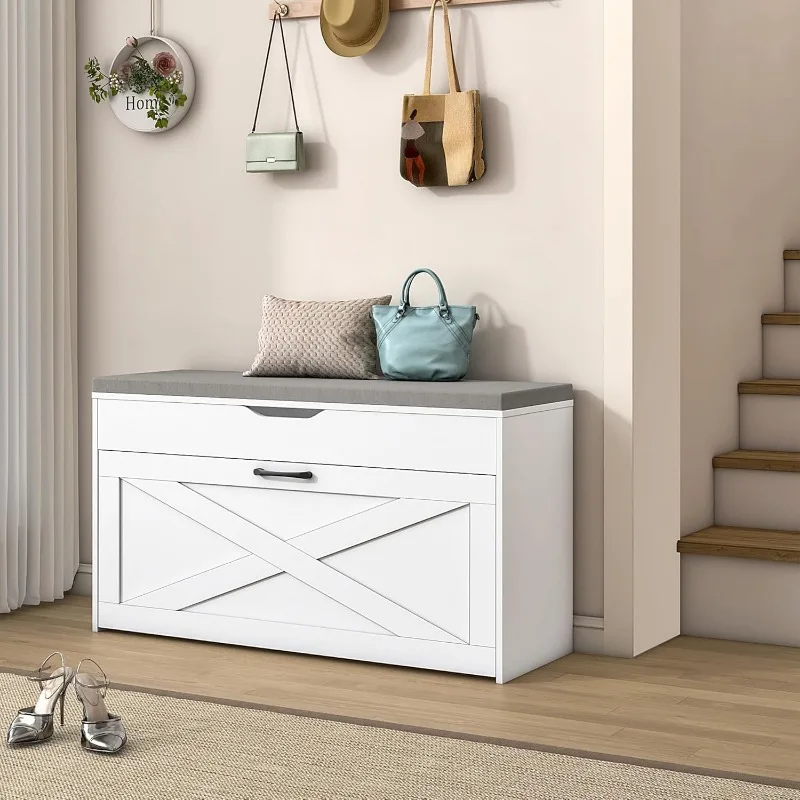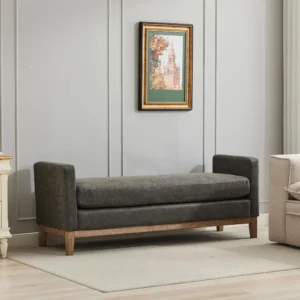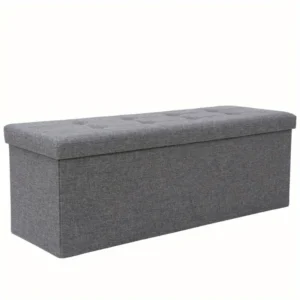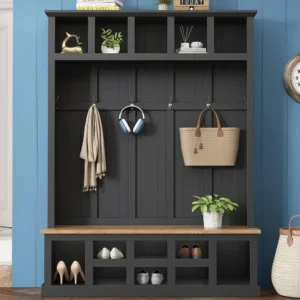The Essential Role of Entryway Storage: Why Shoe Compartments Matter
Your entryway creates the first impression of your home, but it’s also where daily chaos tends to accumulate. Shoes scattered across the floor, keys lost in clutter, and nowhere to set down grocery bags—these common frustrations can make coming home feel stressful rather than welcoming.
Dedicated furniture with shoe compartments offers a thoughtful solution to this everyday problem. These pieces serve a dual purpose: they keep your space tidy while enhancing your home’s style. When shoes have a designated home, your entryway immediately looks more intentional and organized.
Studies show that the average person owns between 12 to 18 pairs of shoes, and for a family of four, that’s potentially 48-72 pairs needing storage! Without proper organization, these items quickly become tripping hazards and eyesores. The right bench with shoe compartments can transform this challenge into an opportunity for elegant storage.
Beyond mere organization, a well-designed entryway creates tangible benefits:
- Reduced morning stress when everyone can find their shoes quickly
- Enhanced home value through thoughtful storage solutions
- Improved household efficiency with designated places for everyday items
Interior designers consistently note that an organized entryway contributes to a sense of calm throughout the home. When you establish order in the first space you encounter, that sense of functional and decluttered space extends to other areas of your home as well.
At Nested Goods, we understand that an entryway isn’t just a transitional space—it’s the foundation for the entire home experience. The right furniture makes all the difference in creating an entrance that’s both beautiful and brilliantly organized.
Assessing Your Entryway Needs: Space, Style, and Storage Requirements
Before selecting the perfect entryway furniture with shoe storage, take time to evaluate what you actually need. This thoughtful assessment will guide you toward solutions that truly work for your space and lifestyle.
Measuring Your Space
Start by measuring your entryway dimensions:
– Width: Measure wall-to-wall where the furniture will go
– Depth: Determine how far furniture can extend without blocking traffic
– Height: Consider ceiling height if looking at taller pieces
Remember to account for door clearance—standard doors need about 30 inches (76 cm) of swing space. For optimal movement, maintain at least 36 inches (91 cm) of walking space in high-traffic areas.
Understanding Traffic Patterns
Consider how people move through your entryway:
– Do multiple people enter simultaneously?
– Is this the main entrance for groceries and packages?
– Do you need a landing spot for items when entering?
Narrow hallways and small foyers present unique challenges that require slim-profile solutions, while more spacious areas can accommodate larger, multi-functional pieces.
Assessing Shoe Storage Needs
The right shoe storage capacity depends on several factors:
– Family size: Count approximately 8-12 pairs per person for regular use
– Seasonal needs: Will you need to store winter boots and summer sandals?
– Activity levels: Athletic households may have additional sporting footwear
– Guest frequency: Do you regularly need to accommodate visitor shoes?
When choosing the perfect bench with shoe storage, consider both current and future needs. Growing families or changing lifestyles might require adaptable storage solutions.
Additional Functionality Requirements
Beyond shoes, what else needs a home in your entryway?
– Seating: Do family members sit to put on/remove shoes?
– Coat storage: Are hooks or a closet needed for outerwear?
– Small item organization: Keys, mail, bags, dog leashes?
– Seasonal item storage: Umbrellas, gloves, hats, sunscreen?
Style Compatibility
Your entryway creates first impressions, so choose furniture that:
– Complements your existing décor style (modern, farmhouse, traditional, etc.)
– Features finishes that coordinate with nearby rooms
– Reflects your personal aesthetic while serving practical needs
By thoroughly assessing these factors, you’ll be better equipped to choose from the narrow entryway bench options or other storage solutions that truly meet your specific requirements.
Types of Entryway Furniture with Shoe Storage: Finding Your Perfect Match
Finding the ideal entryway storage solution means understanding the different options available and how each addresses specific needs and spaces. Here’s a comprehensive look at the main types of furniture that combine entryway functionality with shoe organization.
Entryway Benches with Shoe Storage
These versatile pieces offer seating and shoe storage in one compact unit. Entryway bench storage comes in several configurations:
- Open shelf benches: Provide easy access and visibility for frequently worn shoes
- Cubbied benches: Feature divided spaces for organizing shoes by owner or type
- Drawer-style benches: Allow shoes to be completely hidden from view
- Flip-top storage benches: Offer concealed storage under a lifting seat
Most shoe storage benches range from 36-48 inches (91-122 cm) wide, 16-18 inches (40-46 cm) deep, and can hold 6-12 pairs of shoes depending on the design.
These pieces work exceptionally well in entryways where you need both seating and storage but have limited space for multiple furniture pieces.
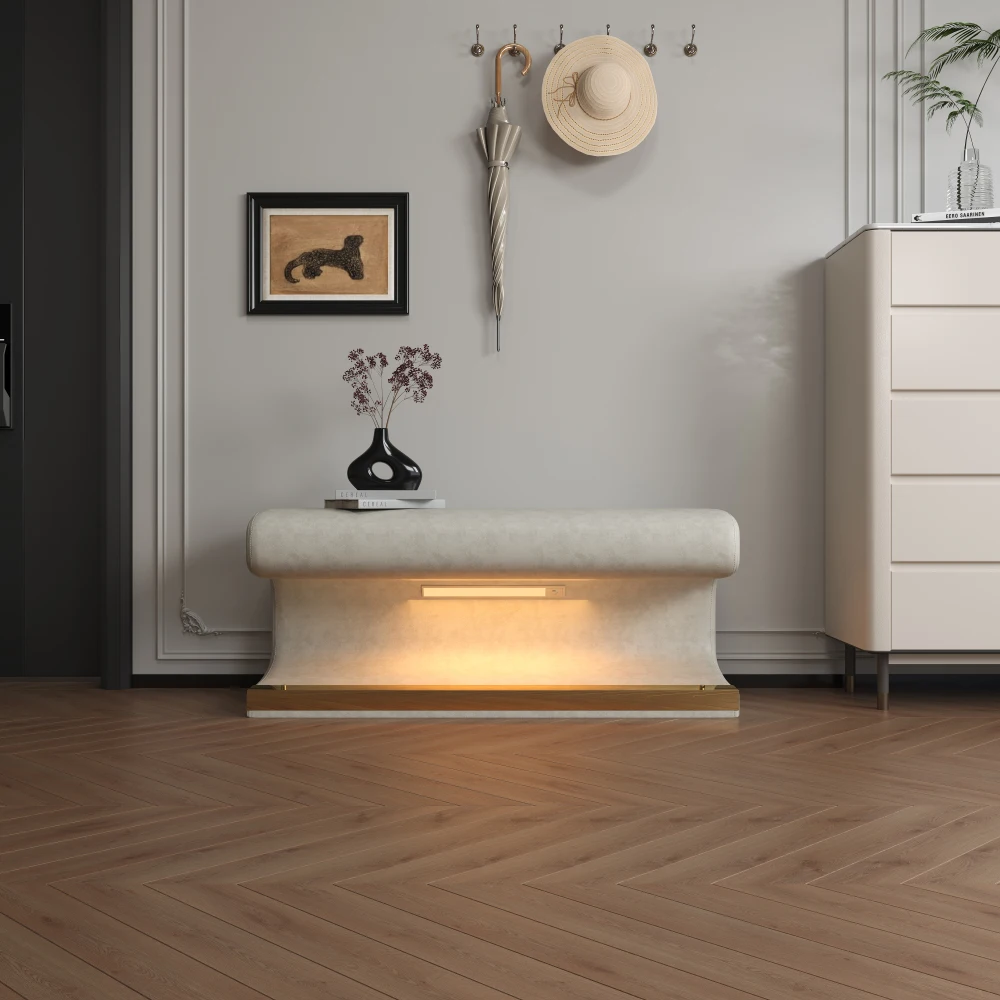
Dedicated Shoe Storage Cabinets
When shoe organization is the primary concern, dedicated cabinets offer maximum efficiency:
- Slim vertical cabinets: Only 8-12 inches (20-30 cm) deep, these space-saving units can hold 12-30 pairs
- Tilt-out designs: Allow shoes to be stored horizontally without taking up floor space
- Double-duty cabinets: Combine shoe storage with drawers for accessories or mail
These cabinets excel at concealing footwear clutter while maintaining a streamlined appearance, perfect for more formal entryways or visible foyers.
Hall Trees with Integrated Shoe Storage
For comprehensive entryway organization, hall trees with coat rack benches offer all-in-one solutions:
- Full hall trees: Combine bench seating, shoe storage, coat hooks, and sometimes mirrors
- Corner hall trees: Utilize otherwise wasted corner spaces
- Compact hall trees: Offer vertical storage in narrower spaces
These units typically stand 6-7 feet (183-213 cm) tall and provide the most complete organization system for entryways with sufficient height and at least 3 feet (91 cm) of wall space.
Console Tables with Shoe Compartments
For entryways where style is paramount but storage remains important:
- Two-tier console tables: Feature a lower shelf for shoes with decorative top surface
- Console tables with cubbies: Combine traditional design with practical storage
- Narrow console designs: Offer slim profiles (10-12 inches/25-30 cm deep) for tight spaces
These pieces work well in formal foyers or when you prefer to highlight decorative elements while still providing some shoe organization.
Storage Ottomans for Shoes
Flexible and multi-functional options include:
- Bench ottomans: Provide both seating and hidden storage
- Modular ottomans: Can be arranged in different configurations
- Rolling ottomans: Offer mobility for adaptable spaces
Storage ottomans typically hold fewer shoes (4-8 pairs) but offer exceptional versatility and can move between the entryway and living spaces as needed.
The diversity of shoe storage bench types ensures there’s a perfect match for every entryway challenge, from tiny apartments to spacious foyers. Consider which combination of features best addresses your specific needs before making a selection.
Material Matters: Durability and Design Considerations
The materials used in your entryway furniture significantly impact both its longevity and how well it complements your home’s aesthetic. Since entryway pieces endure daily use and frequent contact with moisture from shoes, material selection deserves careful consideration.
Wood Options and Considerations
Wooden entryway benches remain among the most popular choices, offering timeless appeal and durability:
- Solid hardwoods (oak, maple, walnut):
- Exceptional durability for high-traffic areas
- Natural resistance to dents and scratches
- Develop character with age
Require occasional maintenance with wood-appropriate cleaners
Pine and softer woods:
- More affordable solid wood option
- Lighter weight makes rearranging easier
- More susceptible to dents but can be refinished
Often used in farmhouse or rustic styles
Engineered woods (MDF, particleboard with veneer):
- Budget-friendly alternative to solid wood
- Can mimic expensive wood species with veneers
- Less resistant to moisture damage
- Good for dry climates or covered porches

Metal Elements
Metal components add both style and structural integrity:
- Steel frames:
- Provide exceptional strength for heavy use
- Contemporary appearance, especially in matte black finishes
- Resistant to damage but may show scratches
Often combined with wood or upholstery
Wrought iron accents:
- Elegant, traditional appearance
- Extremely durable but heavier
- May require occasional rust prevention in humid areas
Upholstered Elements
Fabric and padded components add comfort and style:
- Performance fabrics:
- Stain-resistant and easier to clean
- Available in numerous colors and patterns
- Add softness to otherwise hard surfaces
Consider removable covers for easier maintenance
Leather and faux leather:
- Wipe-clean convenience
- Develops patina with age (genuine leather)
- More resistant to stains than most fabrics
- Appropriate for both modern and traditional styles
Hardware Quality Indicators
Don’t overlook the importance of quality hardware:
- Look for soft-close hinges on cabinets
- Full-extension drawer slides allow complete access to contents
- Reinforced corners prevent wobbling
- Adjustable feet accommodate uneven floors
Material Maintenance Requirements
| Material | Cleaning Requirements | Durability Rating | Climate Considerations |
|---|---|---|---|
| Solid Oak/Maple | Quarterly oiling/waxing | High (20+ years) | Adapts to most climates |
| Pine | Bi-annual sealing | Medium (10-15 years) | May expand/contract with humidity |
| Engineered Wood | Monthly dusting, avoid moisture | Medium (8-12 years) | Best in controlled humidity |
| Metal | Quarterly polishing | High (15+ years) | May require rust prevention in coastal areas |
| Upholstery | Bi-annual deep cleaning | Medium (5-8 years before reupholstering) | Fabric choice affects performance |
By selecting materials that match both your aesthetic preferences and practical requirements, you’ll ensure your entryway furniture remains beautiful and functional for years to come.
Maximizing Function: Essential Features for Effective Shoe Storage
The effectiveness of entryway shoe storage depends largely on thoughtful design features that address real-world needs. Understanding these key elements helps you select furniture that will truly serve your daily routine.
Compartment Design Options
Different compartment designs serve various storage needs:
- Open shelving:
- Provides excellent air circulation to dry damp shoes
- Allows quick visual identification of footwear
- Works best for neat households or when shoes are arranged methodically
Typically accommodates 2-3 pairs per shelf depending on width
Closed cabinets:
- Conceal visual clutter completely
- Protect shoes from dust accumulation
- May reduce air circulation (look for ventilated options)
Ideal for entryways visible from living areas
Cubbies and dividers:
- Create natural organization by user or shoe type
- Prevent shoes from touching (reduces odor transfer)
- Standard cubby size (12”W × 8”H × 12”D / 30cm × 20cm × 30cm) fits most adult shoes
Works well for families to designate personal spaces
Tilt-out compartments:
- Maximize vertical storage in minimal floor space
- Completely conceal shoes while allowing full access
- More complex mechanism but saves considerable space
- Ideal for narrow hallways and small apartments
The way you organize shoes in entryway benches should reflect your family’s habits and the types of footwear you commonly use.
Ventilation Considerations
Proper air circulation is crucial for shoe storage:
- Slatted shelving: Provides natural airflow to dry moisture
- Perforated backs: Allow air to circulate even in closed cabinets
- Open sides or backs: Promote cross-ventilation
- Mesh compartments: Combine organization with excellent airflow
Without adequate ventilation, shoes can develop odors or mildew, particularly in humid climates or during rainy seasons.
Critical Measurements for Functionality
Standard measurements ensure your storage accommodates different footwear types:
- Shelf depth: 10-12 inches (25-30 cm) accommodates most adult footwear
- Height between shelves:
- 6-7 inches (15-18 cm) for flats and low shoes
- 8-10 inches (20-25 cm) for sneakers and casual shoes
- 12-16 inches (30-40 cm) for boots and tall footwear
- Width allocation: Allow 3-4 inches (8-10 cm) per shoe when placed side-by-side
Entryway benches with shelf storage often provide adjustable or varied shelf heights to accommodate seasonal footwear changes.
Seasonal Adaptation Features
Look for furniture that adapts to changing needs:
- Adjustable or removable shelves
- Convertible compartments
- Modular components that can be reconfigured
- Expandable designs that grow with your needs
These features ensure your furniture remains functional year-round, accommodating everything from summer sandals to winter boots.
Multi-Functional Elements
Value-adding features enhance overall functionality:
- Comfortable seating with proper height (17-19 inches/43-48 cm) for easy shoe changes
- Hidden compartments for seasonal accessories
- Built-in umbrella stands with drip trays
- Integrated hooks for bags, coats, or dog leashes
By selecting entryway furniture with thoughtfully designed shoe storage features, you create an organizational system that simplifies your daily routine while keeping your home’s entrance tidy and welcoming.
Beyond Shoes: Additional Storage Solutions for Complete Entryway Organization
While shoe storage forms the foundation of entryway organization, a truly functional space addresses all the items that come and go with you daily. Comprehensive entryway benches with hooks and storage create a complete system for maintaining order.
Integrated Coat and Accessory Storage
Keep outerwear organized and accessible:
- Hook systems: Look for sturdy hooks rated for at least 10-15 pounds (4.5-6.8 kg) to support wet coats
- Optimal hook placement: Position 60-66 inches (152-168 cm) from the floor for adult use, with lower options for children
- Hat and scarf solutions: Integrated shelving above hooks provides perfect storage for seasonal accessories
- Umbrella storage: Dedicated stands with drip trays prevent water damage to floors
Strategic placement of these elements creates natural “stations” for family members to deposit their items when entering and retrieve them when leaving.
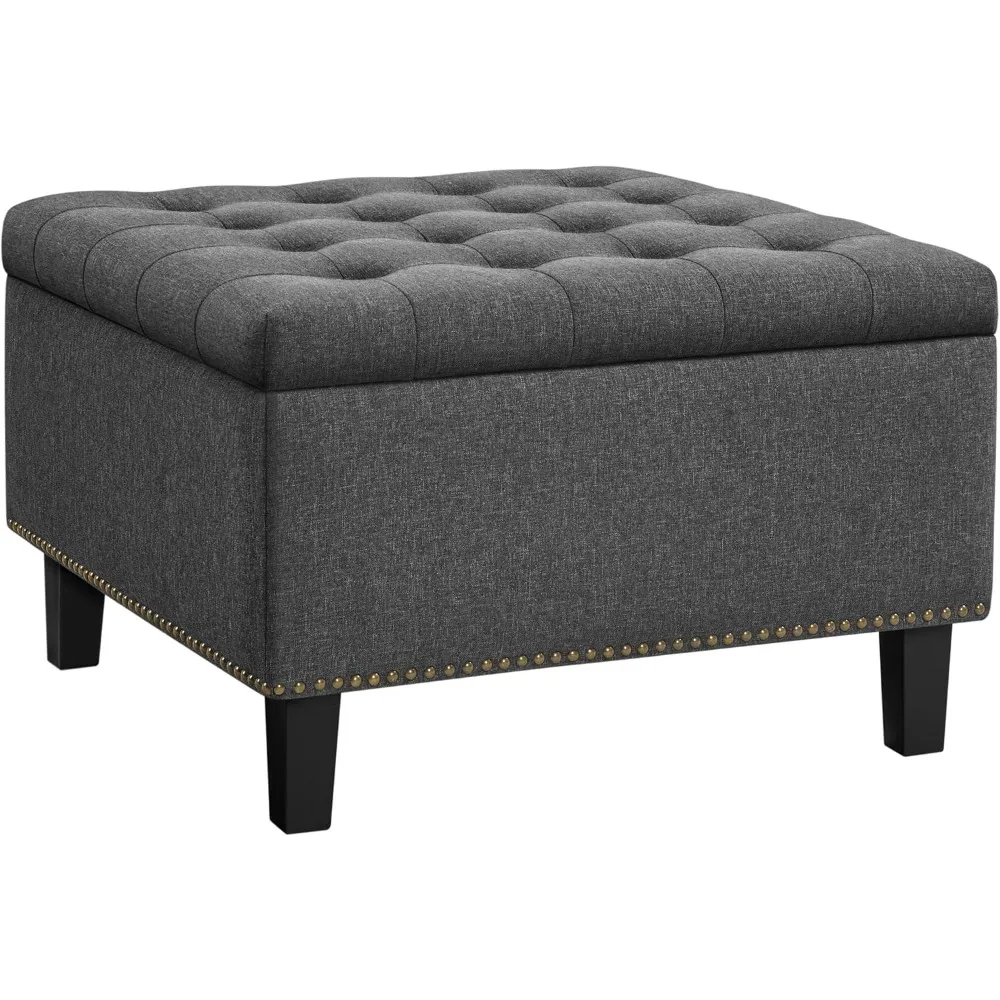
Mail and Key Organization
Prevent the daily hunt for essential small items:
- Mail slots: Divided compartments keep bills and correspondence visible but organized
- Key hooks: Small, dedicated hooks positioned at eye level prevent misplaced keys
- Catch-all trays: Shallow containers contain pocket items like coins and receipts
- Charging stations: Integrated power options keep devices charged and organized
These features save approximately 10 minutes daily in searching for commonly misplaced items—that’s over 60 hours per year for the average family!
Seasonal Item Management
Adapt to changing needs throughout the year:
- Winter storage: Dedicated spaces for gloves, scarves, and hats keep these items paired
- Summer organization: Sunglasses, sunscreen, and hats need accessible spots during warmer months
- School year essentials: Backpack hooks and homework paper management systems
- Holiday adaptations: Flexible storage that accommodates seasonal decorations
The ability to adjust your entryway organization seasonally prevents overflow and maintains functionality year-round.
Pet Accessory Integration
For households with animals, dedicated pet stations streamline daily routines:
- Leash hooks: Positioned near the door at accessible height
- Treat storage: Small containers keep rewards handy for returns
- Paw-cleaning supplies: Towels and wipes in accessible containers
- Toy storage: Prevents tripping hazards from toys left in walking paths
With thoughtful planning, your entryway furniture can address every organizational challenge your household faces daily. The result is a smoother morning routine, stress-free returns home, and an entryway that functions as efficiently as it looks beautiful.
Space-Optimization Strategies: Solutions for Every Entryway Size
No matter the dimensions of your entryway, strategic furniture selection can maximize both storage and style. The key is matching the scale and configuration of your furniture to your specific space constraints while still addressing your organizational needs.
Narrow Hallway Solutions
When width is limited but length is available:
- Slim-profile cabinets: Look for pieces only 8-12 inches (20-30 cm) deep
- Vertical storage utilization: Tall, narrow pieces maximize wall use while minimizing footprint
- Wall-mounted options: Floating shoe cabinets free up valuable floor space
- Behind-door solutions: Over-door organizers or narrow cabinets that fit behind doors
Small shoe benches with minimal depth but adequate width can transform even the narrowest hallways into organized entryways.
Small Apartment Strategies
For truly limited spaces:
- Multi-function necessities: Every piece must serve at least two purposes
- Nesting or folding components: Items that can be reduced in size when not in use
- Scale-appropriate selection: Choose furniture properly proportioned to the space
- Light colors and reflective surfaces: Create the illusion of more space
In apartments under 1,000 square feet (93 square meters), every inch matters. Look for furniture that offers maximum storage capacity in minimal square footage.
Corner Utilization
Transform awkward corners into organizational assets:
- L-shaped configurations: Custom-fit the available space
- Corner-specific furniture: Corner entryway benches are specifically designed for these challenging spaces
- Triangular shelving: Maximizes otherwise wasted corner real estate
- Diagonal placement: Sometimes positioning square furniture diagonally actually saves space
Corner solutions can increase your entryway storage capacity by 20-30% by utilizing space that would otherwise remain empty.
Open Concept Entryway Approaches
When your entryway flows directly into living spaces:
- Room divider furniture: Create definition between spaces
- Double-sided accessibility: Pieces that work from multiple angles
- Style consistency: Select pieces that complement both entry and adjacent room décor
- Visual weight consideration: Choose pieces that don’t block sightlines or light flow
Furniture that serves as a transitional element between spaces can define the entryway without walls or permanent divisions.
Large Foyer Maximization
For generous entry spaces:
- Statement pieces: Larger-scale furniture that anchors the space
- Comprehensive organization systems: Multiple coordinated pieces that work together
- Island configurations: Centrally placed storage accessible from all sides
- Zoned organization: Separate areas for different functions (shoes, coats, mail, etc.)
When space permits, creating distinct functional zones within the entryway improves flow and enhances organization.
By implementing space-specific strategies and selecting furniture properly scaled to your entryway dimensions, you can achieve both beautiful design and practical storage—regardless of space limitations. The wide variety of entry benches with shoe storage available today means there’s a perfect solution for every space challenge.
Our Top Recommendations: Entryway Furniture for Every Need
After analyzing hundreds of entryway storage options, we’ve identified standout choices that excel in addressing specific needs. These recommendations balance quality construction, thoughtful design, and organizational efficiency.
Best for Maximizing Storage in Small Spaces
When square footage is limited but storage needs are substantial:
- Slim Vertical Shoe Cabinets: These space-efficient designs stand just 8-10 inches (20-25 cm) deep while holding 12-24 pairs of shoes in a vertical configuration
- Wall-Mounted Solutions: Floating cabinets free up valuable floor space while providing substantial storage
- Staircase-Style Benches: Graduated shelf heights maximize corner spaces while providing seating
- Under-Bench Basket Systems: Flexible storage that adapts to oddly shaped footwear
Look for furniture that emphasizes vertical storage and uses every available inch efficiently.
Most Versatile Options for Changing Needs
For households with evolving storage requirements:
- Modular Storage Systems: Components that can be reconfigured as needs change
- Adjustable Shelving Options: Movable shelves accommodate seasonal footwear changes
- Convertible Designs: Pieces that transform from one function to another
- Expandable Furniture: Units that grow with your collection or family size
Versatile pieces might cost slightly more initially but provide greater long-term value as they adapt to changing household needs.
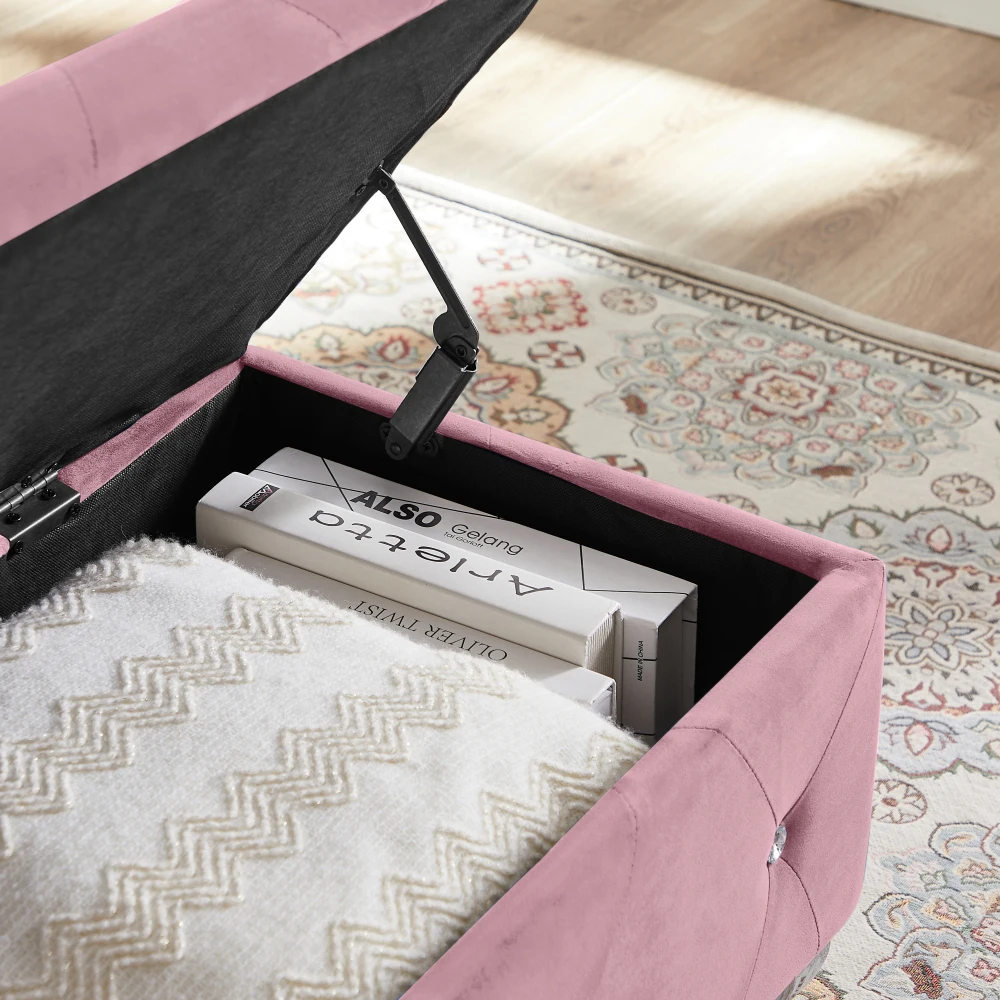
Best for Large Families
When organizing footwear for multiple family members:
- Assigned Cubby Systems: Individual storage spaces for each family member
- High-Capacity Hall Trees: All-in-one solutions with substantial shoe storage and coat hooks
- Extra-Long Bench Designs: Seating for multiple people with corresponding storage
- Stacked Double-Row Storage: Maximized capacity through efficient use of height
Features like color-coded cubbies or labeled compartments enhance organization for busy households with many users.
Entryway Bench with Cushion, Mudroom Bench with Cushion, Shoe Bench for Entryway
$1,186.63 Select options This product has multiple variants. The options may be chosen on the product pageCoat Rack Shoe Bench, Corner Entryway Bench, Corner Hall Tree, Shoe Bench for Entryway
$313.58 Select options This product has multiple variants. The options may be chosen on the product pageShoe Storage Bench for Entryway
$459.02 Select options This product has multiple variants. The options may be chosen on the product pageEntryway Bench with Shelf Storage, Shoe Bench for Entryway, Shoe Storage Bench
$194.08 Select options This product has multiple variants. The options may be chosen on the product pageCorner Entryway Bench, Entryway Bench with Cushion, Modern Entryway Bench, Shoe Bench for Entryway
$476.34 Select options This product has multiple variants. The options may be chosen on the product pageBench with Hooks and Storage, Entryway Hall Tree, Mudroom Bench with Cubbies, Mudroom Bench with Shoe Storage
$818.38 Select options This product has multiple variants. The options may be chosen on the product page
Most Stylish Designs That Don’t Sacrifice Function
For design-conscious homeowners who refuse to compromise on organization:
- Upholstered Top Benches: Beautiful fabric seating with hidden storage below
- Mid-Century Inspired Cabinets: Clean lines and tapered legs with modern storage solutions
- Industrial-Farmhouse Hybrids: Metal and wood combinations with substantial storage capacity
- Decorative Front Panels: Carved or patterned cabinet fronts that disguise practical storage
These options bring designer aesthetics to functional storage pieces, ensuring your entryway makes a positive impression.
Best Value for Long-Term Investment
When seeking quality that will last for years:
- Solid Wood Construction: Pieces built with hardwood frames and quality joinery
- Multi-Function Design: Furniture that serves multiple purposes for continued relevance
- Timeless Styling: Classic designs that won’t quickly look outdated
- Replaceable Components: Items with cushions or hardware that can be updated over time
The best entryway furniture with built-in shoe storage combines practical storage with quality construction that withstands years of daily use.
High-quality shoe storage benches for entryways represent a worthwhile investment in both home organization and design. By selecting pieces that align with your specific needs, you’ll enjoy the benefits of a well-organized entryway for years to come.
Proper Placement: Optimizing Your Entryway Layout
Strategic furniture placement transforms good storage pieces into great organizational systems. The position of your entryway furniture affects not just aesthetics but also daily functionality and traffic flow.
Traffic Flow Fundamentals
Maintain these critical clearances for comfortable movement:
- Primary walkways: Minimum 36 inches (91 cm) wide
- Door clearance: Allow 30 inches (76 cm) for standard door swing
- Face-to-face spacing: 24-30 inches (61-76 cm) between opposing pieces
Observe your household’s natural movement patterns for a week before finalizing furniture placement. Note where people naturally pause, where bottlenecks occur, and how multiple people navigate the space simultaneously.
Wall vs. Floating Placement
Consider these placement strategies:
- Wall placement advantages:
- Maximizes open floor space
- Creates clear traffic lanes
- Provides stability for taller pieces
Works well in most standard entryways
Floating placement benefits:
- Creates room division in open concepts
- Allows access from multiple sides
- Can define the entryway when architectural features are absent
- Works well in larger foyers or open floor plans
In narrow spaces, wall placement is nearly always preferable, while larger areas benefit from strategic floating placement that defines functional zones.
Creating Functional Zones
Establish distinct areas for different entryway activities:
- Arrival zone: Immediate space inside door for shoes and outerwear
- Transition zone: Area for keys, mail, and personal items
- Preparation zone: Mirror and surface for last-minute checks before departing
Entry furniture with open shelving works particularly well when positioned to create these natural zones, guiding household members through an intuitive organizational system.
Light and Space Perception
Enhance your space through thoughtful arrangement:
- Position mirrors to reflect natural light sources
- Keep taller pieces away from windows when possible
- Use lighter colored furniture in darker entryways
- Consider furniture with open or glass components in very small spaces
By applying these placement strategies, even modest entryway furniture can create maximum organizational impact while maintaining an inviting, uncluttered appearance.
Styling Your Entryway: From Functional to Fabulous
Once you’ve selected the perfect entryway furniture with shoe storage, thoughtful styling transforms it from merely functional to truly fabulous. These finishing touches personalize your space while maintaining its organizational efficiency.
Surface Styling Strategies
Create beautiful yet practical top surfaces:
- Decorative trays: Corral small items while adding style
- Strategic lighting: Table lamps or wall sconces add warmth and visibility
- Personal touches: Select meaningful objects that welcome you home
- Seasonal elements: Rotate simple décor to reflect changing seasons
The key is balance—leave enough empty space for daily items while incorporating elements that bring joy and reflect your personal style.
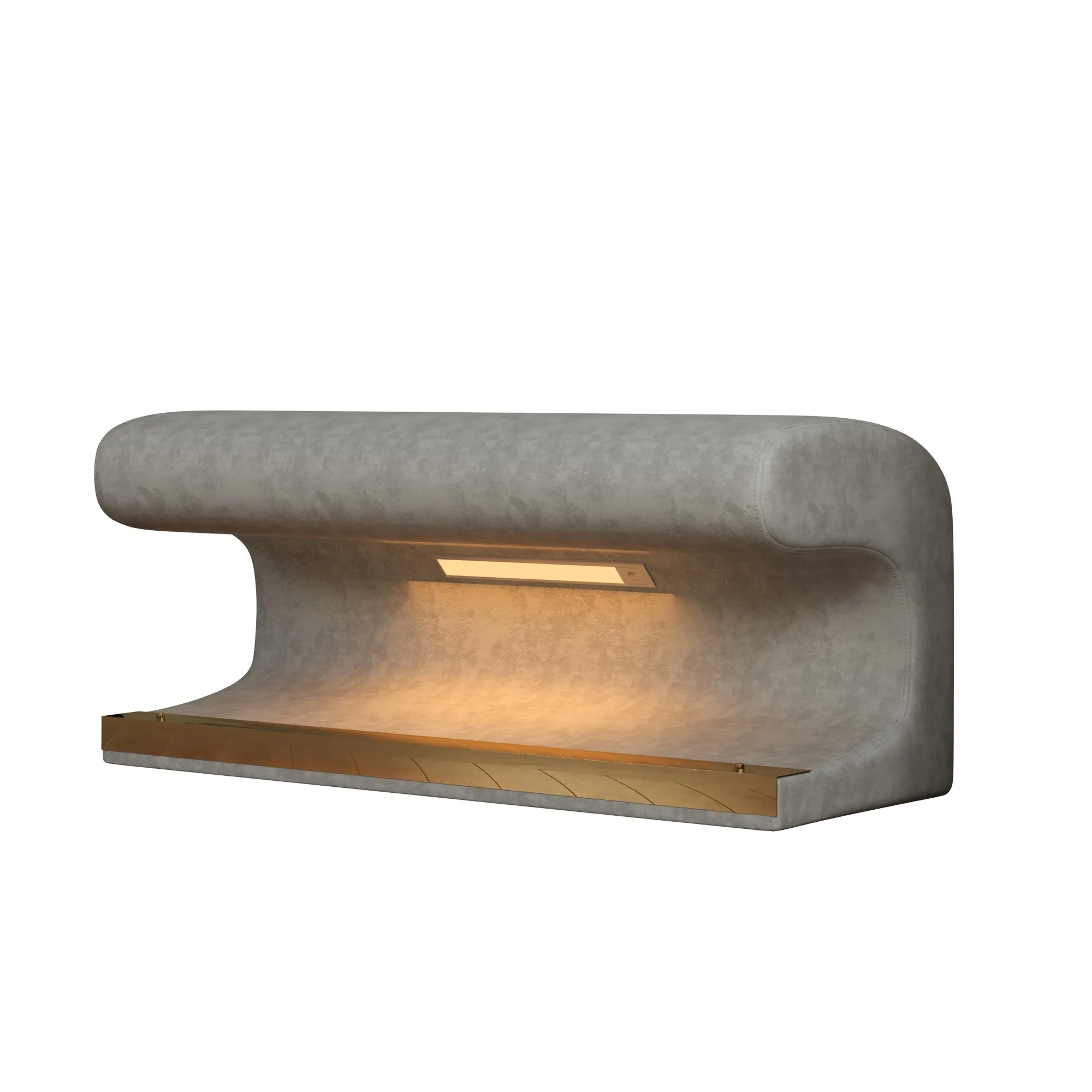
Wall Space Enhancement
Utilize vertical space to complete your entryway design:
- Mirror placement: Position mirrors to reflect light and create the illusion of space
- Artwork integration: Select pieces that establish the color palette for your entryway
- Wall-mounted organizers: Decorative mail sorters, key hooks, or small shelves
The wall space above and around your furniture should complement its function while adding visual interest to the entire entryway.
Textile Additions
Soft elements add comfort and style:
- Runner selection: Choose durable, washable options for high-traffic areas
- Cushion considerations: Entryway bench cushions add comfort and color while softening hard surfaces
- Seasonal adaptations: Heavier fabrics and deeper colors in winter, lighter options in summer
Textiles should be both beautiful and practical—stain-resistant fabrics and washable covers are worth the investment for these high-use areas.
Color Coordination
Create visual harmony through thoughtful color selection:
- Pull colors from adjacent rooms for cohesive flow
- Use the 60-30-10 rule: 60% dominant color, 30% secondary color, 10% accent color
- Consider the mood you want to create—energizing or calming
- Remember that neutrals provide timeless appeal for investment pieces
Your entryway color scheme sets the tone for your entire home, so choose wisely based on the atmosphere you want to create.
Balancing Function and Design
Maintain the perfect balance between beauty and practicality:
- Keep frequently used items accessible but contained
- Create visual breathing room by avoiding overcrowding
- Group similar items together for visual cohesion
- Layer textures and materials for design depth
With thoughtful styling, your entryway becomes not just an organizational workhorse but also a beautiful introduction to your home that reflects your personal style and welcomes both family and guests.
Maintenance and Care: Preserving Your Entryway Investment
Proper maintenance ensures your entryway furniture remains beautiful and functional for years to come. Since these pieces endure daily use in a high-traffic area, consistent care is essential for longevity.
Material-Specific Cleaning Protocols
Different materials require specific care approaches:
Wood Care:
– Dust weekly with a soft, slightly damp cloth
– Clean quarterly with appropriate wood cleaner
– Apply furniture polish or wax 2-3 times yearly
– Address spills immediately to prevent staining
– Use coasters under wet items to prevent water rings
Metal Maintenance:
– Wipe with a dry cloth for routine cleaning
– Use appropriate metal cleaner monthly for polished surfaces
– Check for and treat any signs of rust promptly
– Apply metal protectant to prevent tarnishing
Upholstery Protection:
– Vacuum fabric surfaces weekly using upholstery attachment
– Treat stains immediately following manufacturer recommendations
– Consider professional cleaning annually for heavily used pieces
– Apply fabric protector to new or freshly cleaned surfaces
The cushions on shoe benches should be vacuumed regularly and, if removable, washed according to the fabric care instructions.
Preventative Maintenance Strategies
Regular check-ups prevent small issues from becoming major problems:
- Tighten hardware quarterly as normal use can loosen screws and bolts
- Inspect for signs of wear or damage monthly
- Reposition furniture periodically to prevent uneven wear
- Use furniture pads under legs to protect both the furniture and flooring
- Apply felt bumpers to cabinet doors to prevent slamming
Environmental Protection
Shield your furniture from environmental factors:
- Position pieces away from direct sunlight to prevent fading
- Maintain consistent indoor humidity (40-50%) to prevent wood cracking
- Use dehumidifiers in damp conditions to protect against mold and mildew
- Consider seasonal adjustments—move furniture away from heating vents in winter
Refresh and Update Possibilities
Even well-maintained pieces sometimes need refreshing:
- Replace hardware for an updated look
- Refinish wood surfaces when showing significant wear
- Reupholster bench tops when fabric becomes worn or dated
- Apply a fresh coat of paint to revitalize painted pieces
With proper care, quality entryway furniture can remain beautiful and functional for 10-20 years, making it a worthwhile investment in your home’s organization and style.
FAQ: Common Questions About Entryway Furniture with Shoe Storage
How many shoes can typical entryway storage furniture accommodate?
Storage capacity varies significantly based on design and dimensions:
– Standard entryway benches typically hold 6-10 pairs
– Dedicated shoe cabinets can store 12-24 pairs depending on height
– Hall trees with bench storage usually accommodate 8-12 pairs
– Vertical shoe cabinets can hold up to 30 pairs in a compact footprint
For accurate capacity planning, measure your family’s most commonly worn shoes and compare to the interior dimensions of compartments.
What’s the best material for entryway furniture that will encounter wet or snowy shoes?
For areas with frequent moisture exposure:
– Solid hardwoods with water-resistant finishes
– Metal frames with moisture-resistant shelving
– Synthetic materials designed for outdoor/indoor use
– Natural woods with excellent moisture resistance (teak, cedar)
Also consider furniture with removable trays or mats that can be emptied and cleaned regularly during wet weather seasons.
How can I prevent shoe odors in enclosed storage compartments?
Manage odors with these strategies:
– Choose furniture with ventilation features (slats, perforations)
– Place cedar blocks or activated charcoal deodorizers in cabinets
– Use washable liners that can be regularly cleaned
– Allow wet shoes to dry completely before storing in closed compartments
– Consider furniture with removable compartments that can be aired out
Are open shelves or closed cabinets better for shoe storage in entryways?
The best choice depends on your specific needs:
– Open shelves offer better ventilation and quick access
– Closed cabinets provide a neater appearance and hide visual clutter
– Combination pieces with both open and closed storage often provide the best versatility
– Consider your family’s habits—do shoes get neatly placed or quickly kicked off?
What’s the ideal bench height for comfortable shoe changing?
Ergonomic seating options for foyers typically measure:
– 17-19 inches (43-48 cm) from floor to seat top
– This height accommodates most adults comfortably
– For households with children, consider benches with a slightly lower height (15-16 inches/38-41 cm)
– Test by sitting and mimicking the motion of putting on shoes—your knees should form approximately a 90-degree angle
How do I maximize shoe storage in an extremely small entry area?
For minimal spaces:
– Utilize vertical storage with tall, narrow cabinets
– Consider over-door organizers on nearby closet doors
– Look for dual-purpose pieces like small storage ottomans
– Install floating wall shelves above bench seating
– Choose furniture with angled or corner designs to maximize awkward spaces
Can entryway furniture with shoe storage work in open floor plans?
Absolutely, with these approaches:
– Select pieces that look finished from all viewing angles
– Choose furniture that complements both entryway and adjacent room décor
– Use storage furniture as natural room dividers to define the entry space
– Consider backs or sides with decorative elements if they’ll be visible from living areas
How should I organize different family members’ shoes in shared storage?
Create efficient systems with these strategies:
– Assign specific cubbies or shelves to each person
– Use color-coding or labels for younger children
– Position children’s shoes on lower shelves for independence
– Create separate zones for frequently worn versus occasional shoes
– Consider rotating seasonal footwear to alternative storage when not needed
Creating a Complete Entryway System: Beyond Single Furniture Pieces
While standalone furniture offers significant organization benefits, a thoughtfully designed entryway system creates comprehensive solutions for even the most challenging spaces. By combining complementary pieces and considering your entryway as a complete organizational zone, you can maximize both functionality and style.
Complementary Furniture Combinations
Create synergy through strategic furniture pairing:
- Slim shoe cabinets with wall-mounted hook systems: Maximize vertical storage without increasing floor footprint
- Bench seating with overhead shelving or cabinets: Utilize the entire wall height for storage
- Console tables paired with specialized shoe storage: Separate functions while maintaining a cohesive look
- Corner bench with linear cabinet extension: Maximize awkward spaces while creating continuous storage
These combinations often provide 30-40% more storage capacity than single pieces alone while creating a custom-designed appearance.
Creating Cohesive Organizational Zones
Design your entryway with distinct functional areas:
- Arrival zone: Immediately inside the door for shoes, bags, and initial set-down
- Transition zone: Where daily preparation happens (mirror, key storage, mail sorting)
- Connection zone: The area linking your entryway to adjacent living spaces
Each zone should feature appropriate storage solutions while maintaining visual flow between areas. Entry furniture with shoe storage solutions works most effectively when positioned within these logical zones.
Modular Approaches for Evolving Needs
Build systems that can grow and change:
- Expandable systems: Units designed to connect with matching extensions
- Stackable components: Pieces that can be added vertically as needs increase
- Complementary add-ons: Accessories designed to enhance base furniture
- Reconfigurable elements: Units that can be repositioned as needs change
Modular approaches allow your storage to evolve alongside your family’s changing needs without requiring complete replacement.
Integration with Adjacent Spaces
Create seamless transitions between your entryway and neighboring rooms:
- Style continuity: Select pieces that complement adjacent room décor
- Color coordination: Use consistent color palettes or complementary tones
- Functional flow: Consider how movement happens between spaces
- Visual connection: Create sight lines that unify rather than separate areas
When properly executed, a comprehensive entryway storage solution for busy homes doesn’t just organize your entrance—it enhances the function and appearance of your entire home. By thinking beyond individual furniture pieces to complete systems, you create an entryway that truly supports your lifestyle while making a positive impression on everyone who enters your home.

